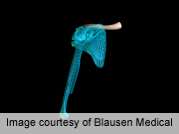Retear rates after arthroscopic repair of both partial-thickness and full-thickness rotator cuff tears are low, with no difference in the retear rate or postoperative shoulder stiffness rate for tear thickness, according to a study published in the June 20 issue of The Journal of Bone & Joint Surgery.
(HealthDay) -- Retear rates after arthroscopic repair of both partial-thickness and full-thickness rotator cuff tears are low, with no difference in the retear rate or postoperative shoulder stiffness rate for tear thickness, according to a study published in the June 20 issue of The Journal of Bone & Joint Surgery.
Karin S. Peters, M.D., from Kliniek Klein Rosendael in the Netherlands, and colleagues compared outcomes for 105 consecutive patients who had a full-thickness rotator cuff tear measuring <3 cm² with 64 patients who had a partial-thickness tear. A knotless single-row arthroscopic repair was used to fix all tears. Patients were assessed using the American Shoulder and Elbow Surgeons (ASES) score preoperatively and at six, 12, and 24 weeks and two years after surgery.
The researchers found that, in both groups, examiner-determined postoperative stiffness was common at six weeks (50 percent in the partial-thickness versus 47 percent in full-thickness groups). Compared with preoperative findings, stiffness decreased from preoperative findings to 21 and 19 percent, respectively, at three months and to 15 and 14 percent, respectively, at six months. At six months the ultrasound-determined retear rate was low (5 and 10 percent in the partial-thickness and full-thickness groups, respectively), but increased at 24 months to 10 and 20 percent, respectively. At both six months and 24 months the ASES score and all pain scores were significantly improved from preoperative scores in both groups.
"Arthroscopic repair of partial-thickness and small- and medium-sized full-thickness rotator cuff tears was associated with excellent medium-term clinical outcomes with low retear rates," the authors write.
One of the institutions received funding from the ArthroCare Corporation.
Full Text (subscription or payment may be required)
Copyright © 2012 HealthDay. All rights reserved.


















